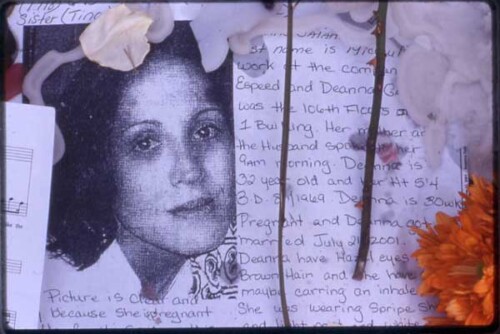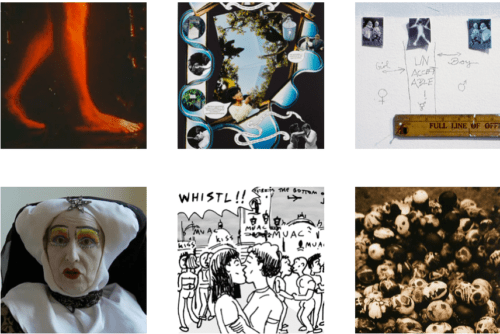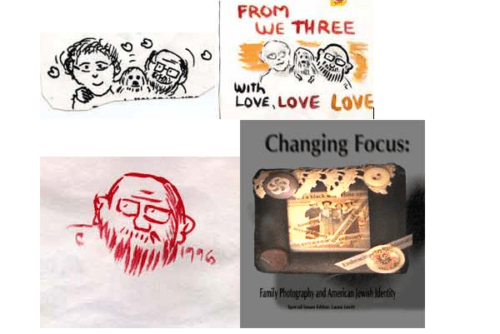Conclusion
In my Introduction, I noted that human rights activists often deploy various genres of testimony simultaneously, each of which circulates in particular arenas, reaching particular audiences. I want to conclude by suggesting we think about this practice in terms of activists’ use of different “registers” to construct political issues. These registers feed off and at times clash with each other in interesting and productive ways. For instance, logocentric and realist forms of documentary evidence and testimony continue to play a fundamental role in the work done by human rights lawyers; they remain powerfully persuasive to U.S. Congressional committees, international legal bodies, and nongovernmental organizations that seek to influence policy rather than mass audiences. Human rights documentary film and video, though they rely on a similar concept of visible evidence, are visual media and as such have a capacity to generate emotion in audiences through the use of evocative storytelling and affective imagery. Activists use this form to mobilize new publics around individuals who function as “nodal points” in a transnational network of identification and solidarity (Nelson 305). Through victims’ onscreen narratives or testimonies, witnesses are situated as potential ethical actors that might intervene in the situation that produced the suffering which is on display.
Finally, we know that new media refashion prior media forms such as writing, film, and photography, and that this process of “remediation” (Bolter and Grusin 1999) upends old ideas about subjects and participants, producers and texts that underpin theories about how media work. So, for instance, if we look at human rights websites we find that instead of occupying just one position, we occupy multiple shifting positions (as voyeurs, as consumers, as activists). How does this multiple positioning square with the argument made above that human rights media offer one subject position, that of witness with ethical responsibility? Understanding the ways in which digital activism might reshape the possible horizon of identities and actions that can be produced is critical to making sense of the new arenas of practice and publicity that are emerging around human rights.
Works Cited
Adams, Vincanne. “Suffering the Winds in Lhasa: Politicized Bodies, Human Rights, Cultural Difference and Humanism in Tibet” in Medical Anthropology Quarterly 12.1 (1998): 74-102.
Bolter, Jay and Richard Grusin. Remediation. Cambridge, MA: MIT Press, 1999.
Bradley, Mark and Patrice Petro eds. Truth Claims: Representation and Human Rights. New Brunswick, NJ: Rutgers University Press, 2002.
Brysk, Alison. “‘Hearts and minds’: Bringing Symbolic Politics Back In” in Polity 27.4 (1995): 559-588.
Calhoun, Craig. Neither Gods nor Emperors: Students and the Struggle for Democracy in China. Berkeley: University of California Press, 1994.
Cizek, Katerina and Peter Wintonick, dirs. Seeing is Believing: Handicams, Human Rights, and the News. First Run/Icarus Films. 2002. 58 min. color. Video.
Clark, Ann Marie. Diplomacy of Conscience: Amnesty International and Changing Human Rights Norms. Princeton, NJ: Princeton University Press, 2001.
Cmiel, Kenneth. “The emergence of human rights politics in the United States” in The Journal of American History. December 86.3 (1999): 1231-1250.
Cohen, Stanley. “Government Responses to Human Rights Reports: Claims, Denials, and Counterclaims,” in Human Rights Quarterly. 18.3 (1994): 517-543.
–. States of Denial: Knowing about Atrocities and Suffering. Cambridge: Polity Press, 2001.
Cox, Christopher. “Marketing Human Rights: Amnesty International Group Tries New Tactics in Support of Political Prisoners,” Boston Herald, 3 January 2002. See http://www.tibet.ca/wtnarchive/2002/2/3_4.html. Accessed 25 April 2003.
Crawford, Neta. Argument and Change in World Politics: Ethics, Decolonization, and Humanitarian Intervention. Cambridge: Cambridge University Press, 2002.
Feldman, Allen. “On Cultural Anesthesia: From Desert Storm to Rodney King” in The Senses Still: Memory and Perception as Material Culture in Modernity. C.N. Serematakis, ed. Chicago: University of Chicago Press, 1996.
–. “X-children and the Militarization of Everyday Life: Youth, Victimage, and Violence in Transitional Societies,” International Journal of Social Welfare. 11.4 (2002): 286-299.
Gaines, Jane. “Political Mimesis,” in Collecting Visible Evidence. Jane Gaines and Michael Renov, eds. Minneapolis: University of Minnesota Press, 1999. 84-102.
Ginsburg, Faye. “From Little Things Big Things Grow: Indigenous Media and Cultural Activism,” in Between Resistance and Revolution: Cultural Politics and Social Activism, ed. Richard Fox and Orin Starn. New Brunswick, NJ: Rutgers University Press, 1997. 118-144.
Hartman, Geoffrey. “Tele-Suffering and Testimony in the Dot Com Era,” in Visual Culture and the Holocaust, ed. Barbie Zelizer. New Brunswick, NJ: Rutgers University Press, 2001. 111-126.
Hesford, Wendy and Wendy Kozol, “Cover Issues: Visual Rhetoric and the Gendered Subject of Human Rights,” in Just Advocacy: Women’s Human Rights, Transnational Feminism, and the Politics of Representation. Edited by Wndy Hesford and Wendy Kozol. New Brunswick, NJ: Rutgers University Press. In press.
Juhasz, Alexandra “They Said We Were Trying to Show Reality, All I Want Is To Show My Video: The Politics of the Realist Feminist Documentary,” in Collecting Visible Evidence. Edited by Jane Gaines and Michael Renov. Minneapolis: University of Minnesota Press, 1999. 190-215.
Keck, Margaret and Kathryn Sikkink. Activists Beyond Borders: Advocacy Networks in International Politics. Ithaca: Cornell University Press, 1998.
Keenan, Tom. “Publicity and Indifference: Media, Surveillance, ‘Humanitarian Intervention’,” in Rhetorics of Surveillance from Bentham to Big Brother. Thomas Levin, Ursula Frohne, and Peter Weibel, eds. Karlsruhe: ZKM, and Cambridge: MIT Press, 2002. 544-561.
Klein, Naomi. No Logo: Taking Aim at the Brand Bullies. New York: Picador, 1999.
Lennox, Annie. Dir. Testimony: Annie Lennox in Conversation with Palden Gyatso. TVE. Video. 54 min. 1998.
Linfield, Susie. “Beyond the Sorrow and the Pity.” Dissent. 48:1 (2001): 9-21.
Manovich, Lev. “Generation Flash.” www.rhizome.org. Accessed 23 April 2003.
McLagan, Meg. “Computing for Tibet: Virtual Politics in the Post-Cold War Era.” In Connected: Engagements with Media, ed. George Marcus. Chicago: University of Chicago Press, 1996. 159-194.
–. “Spectacles of Difference: Cultural Activism and the Mass Mediation of Tibet,” in Media Worlds: Anthropology on New Terrain, eds. Faye Ginsburg, Lila Abu-Lughod, and Brian Larkin. Berkeley: University of California Press, 2002. 90-111.
–. “Principles, Publicity, and Politics: Notes on Human Rights Media” in American Anthropologist 105.3 (forthcoming).
Nelson, Diane. “Indian Giver or Nobel Savage: Duping, Assumptions of Identity, and other Double Entendres in Rigoberta Menchu Tum’s Stollen past” in American Anthropologist 28.2 (2001): 303-331.
Nichols, Bill. Representing Reality. Bloomington: Indiana University Press, 1991. 17-42.
–. “The Trials and Tribulations of Rodney King,” in Blurred Boundaries: Questions of Meaning in Contemporary Culture. Ed. Bill Nichols. Bloomington: Indiana University Press. 1994.
Rafael, Vincente. “The Cell Phone and the Crowd: Messianic Politics in the Contemporary Philippines.” Public Culture 15.3 (forthcoming).
Ronell, Avital. “Video/Television/Rodney King: Twelve Steps Beyond the Pleasure Principle,” differences: A Journal of Feminist Cultural Studies 4.2 (1992): 1-15.
Salecl, Renata. “Why Would One Pretend To Be a Victim of the Holocaust?” in Other voices 2.1 (February 2000). http://www.othervoices.org/2.1/salecl/wilkomirski.html, accessed July 16, 2003.
Scarry, Elaine. The Body in Pain: The Making and Unmaking of the World. New York: Oxford University Press, 1985.
Sreberny-Mohammadi, Annbelle and Ali Mohammadi. Small Media, Big Revolution: Communication, Culture, and the Iranian Revolution. Minneapolis: University of Minnesota Press, 1994.
Williams, Linda. Viewing Positions: Ways of Seeing Film. New Brunswick: Rutgers University Press, 1994.
Wilson, Richard. Human Rights, Culture and Context: Anthropological Perspectives. London: Pluto Press, 1997.
Woodhead, Leslie. Dir. Srebernica: A Cry from the Grave. UK. WNET. 104 minutes, Beta.
Ziv, Ilan. Consuming Hunger. Maryknoll World Productions. 3 pt. Series, 30 min. each. Video. 1988.




